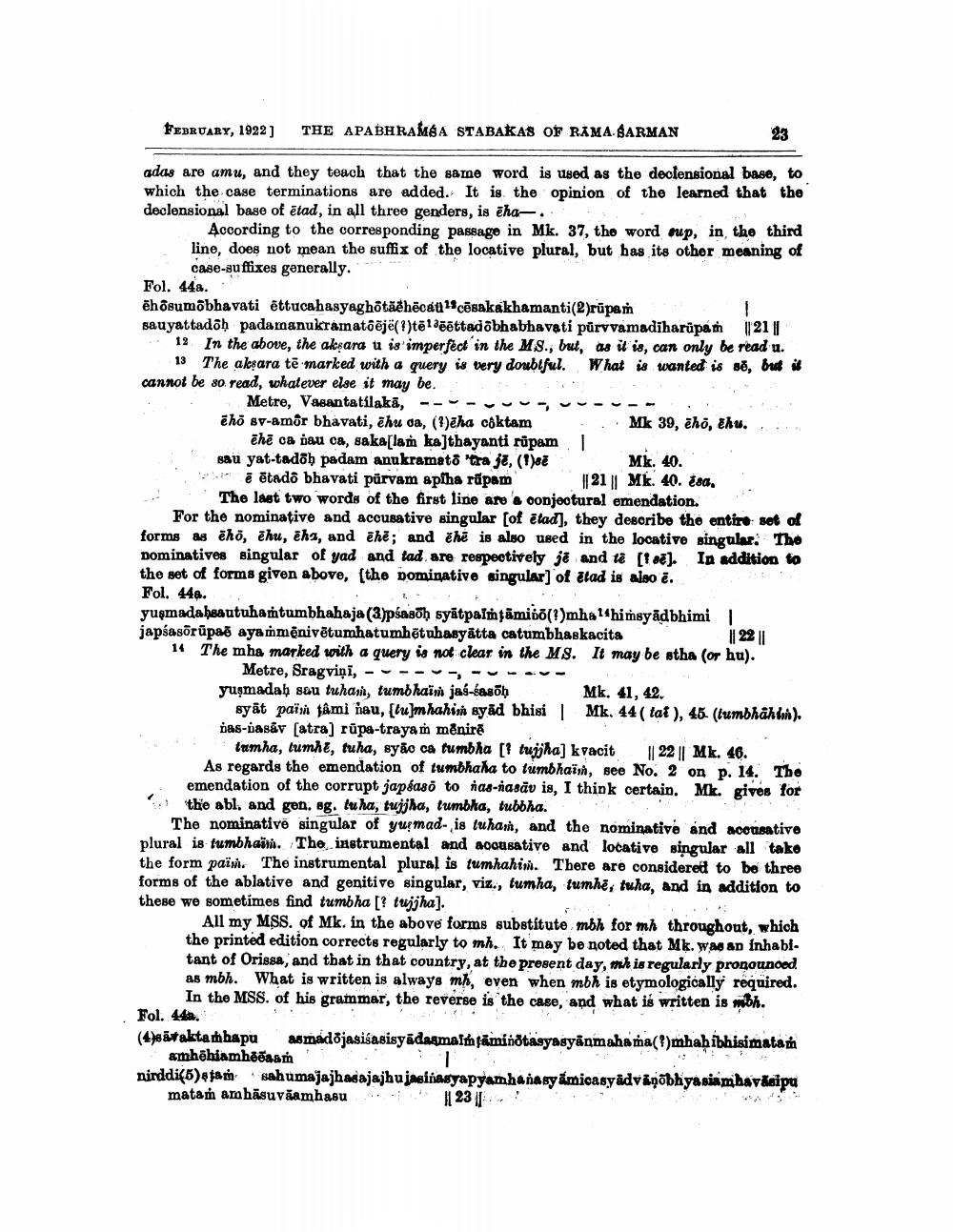________________
FEBRUARY, 1922] THE APABHRAMSA STABAKAS OF RAMA SARMAN
adas are amu, and they teach that the same word is used as the declensional base, to which the case terminations are added. It is the opinion of the learned that the declensional base of etad, in all three genders, is eha-.
According to the corresponding passage in Mk. 37, the word sup, in, the third line, does not mean the suffix of the locative plural, but has its other meaning of case-suffixes generally.
Fol. 448.
1
ehōsumobhavati êttucahasyaghōtaehecat cesakakhamanti(2)rupam sauyattadoḥ pada manukramatõëjë(?)të13ēēttadōbhabhavati pūrvvamadiharupam ||21|| 12 In the above, the aksara u is imperfect in the MS., but, as it is, can only be read u. What is wanted is so, but it
13 The aksara te marked with a query is very doubtful.
cannot be so read, whatever else it may be.
Metre, Vasantatilaka,
eho sv-amor bhavati, ehu oa, (3)ēha côktam
ēhe ca iau ca, sakallam ka]thayanti rupam | sau yat-tadoh padam anukramato 'tra je, (1)së bē ētado bhavati purvam aptha rupam
The last two words of the first line are a conjectural emendation.
For the nominative and accusative singular [of etad], they describe the entire set of forms as eho, ehu, eha, and ehe; and he is also used in the locative singular. The nominatives singular of yad and tad are respectively je and të [1 së]. In addition to the set of forms given above, [the nominative singular] of etad is also ē.
Fol. 440.
yuşmadabeautuhaṁtumbhahaja (3)piash systpalmjämiső(1)mha14himsyidbhimi | japsasōrupa ayammēnivētumhatumhetuhasyatta catumbhaskacita
14 The mha marked with a query is not clear in the MS. It may be stha (or hu).
Mk 39, eho, Ehu.
Mk. 40.
||21|| Mk. 40. ésa.
Metre, Bragvini,
yuşmadaḥ sau tuham, tumbhaïm jaś-sasõḥ
syat pain tâmi hau, [tu]mhahim syad bhisi bas-iasav [atra] rupa-trayam manirễ
|| 22 || Mk. 46.
tumha, tumhe, tuha, syac ca tumbha [ tujjha] kvacit As regards the emendation of tumbhaha to tumbhain, see No. 2 on p. 14. The emendation of the corrupt japéaso to nas-nasäv is, I think certain. Mk. gives for the abl, and gen. eg. tuha, tujjha, tumbha, tubbha.
23
amhēhiamheeaam
The nominative singular of yumad- is tuham, and the nominative and accusative plural is tumbha. The instrumental and accusative and locative singular all take the form pain. The instrumental plural is tumhahim. There are considered to be three forms of the ablative and genitive singular, viz., tumha, tumhe, tuha, and in addition to these we sometimes find tumbha [? tujjha].
nirddi(5)ja
All my MSS. of Mk. in the above forms substitute mbh for mh throughout, which the printed edition corrects regularly to mh. It may be noted that Mk. was an inhabitant of Orissa, and that in that country, at the present day, mh is regularly pronounced as mbh. What is written is always mh, even when mbh is etymologically required. In the MSS. of his grammar, the reverse is the case, and what is written is mbh.
Fol. 44. (4)ñaktamhapu
asmadojasiianiny&daamalṁ jämiöötasyasyanmahama(1)mhabibhisimatan
matam amhasuvaamhasu
Mk. 41, 42.
Mk. 44 ( tat), 45 (lumbhāhim).
||23||
T
sahumajajhaeajajhujaaliasyapyamhadasy Amiensydväqöbhyasiamhavipu




